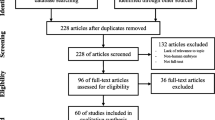Abstract
Purpose: A mouse model was used to evaluate the consequences of partial cytoplasm removal, which mimics the consequence of human early embryo fragmentation, at the one-cell stage on embryonic development to the morula and blastocyst stages.
Results: Opening the zona pellucida at the zygote stage has no detrimental effect on the number of differentiated or total cells at morulalblastocyst stage. However, reduced cytoplasm significantly affects the number of inner cell mass cells, 21.7 (10% cytoplasm removed) vs 27.6 (control) and 15.1 (20% cytoplasm removed) vs 24.7 (control).
Conclusions: The contribution of cytoplasm of maternal origin is critical to early embryonic development.
Similar content being viewed by others
References
Cohen J, Alikani M, Reing A, Ferrara T, Trowbridge J, Tucker M: Selective assisted hatching of human embryos. Ann Acad Med College Med Singapore 1992;21(4):565–570
Braude PR, Bolton V, Moore S: Human gene expression first occurs between the four- and eight-cell stages of preimplantation development. Nature 1988;332:459–461
Telford NA, Watson AJ, Schultz GA: Transition from maternal to embryonic control in early mammalian development: A comparison of several species. Mol Reprod Dev 1990;26:90–100
Hogan B, Costantini F, Lacy E: Manipulating the Mouse Embryo. A Laboratory Manual, Cold Spring Harbor, NY, Cold Spring Harbor Laboratory Press, 1986
Handyside AH, Hunter S: A rapid procedure for visualising the inner cell mass and trophectoderm nuclei of mouse blastocysts in situ using polynucleotide-specific fluorochromes. J Exp Zool 1984;231:429–434
Alikani M, Cohen J: Micromanipulation of cleaved embryos cultured in protein-free medium: A mouse model for assisted hatching. J Exp Zool 1992;263:458–463
Alikani M, Olivennes F, Cohen J: Microsurgical correction of partially degenerate mouse embryos promotes hatching and restores their viability. Hum Reprod 1993;8:1723–1728
Tesarik J: Developmental failure during the preimplantation period of human embryogenesis.In The Biological Basis for Early Human Reproductive Failure. Van Blerkom (ed). New York, Oxford University Press, 1994, pp 320–344
Author information
Authors and Affiliations
Rights and permissions
About this article
Cite this article
Xu, K., Rosenwaks, Z. The importance of cytoplasm in early embryonic development. J Assist Reprod Genet 13, 251–253 (1996). https://doi.org/10.1007/BF02065945
Received:
Accepted:
Issue Date:
DOI: https://doi.org/10.1007/BF02065945




